国际船舶和港口设施保安规则ISPSCode
- 格式:ppt
- 大小:1.16 MB
- 文档页数:31
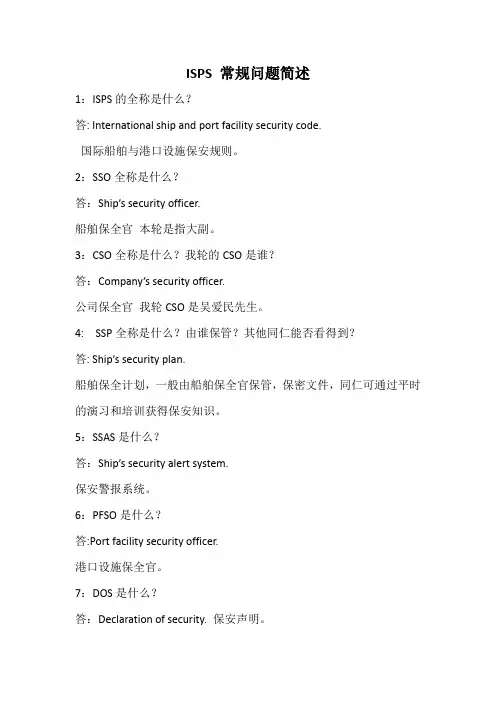
ISPS 常规问题简述
1:ISPS的全称是什么?
答: International ship and port facility security code.
国际船舶与港口设施保安规则。
2:SSO全称是什么?
答:Ship’s security officer.
船舶保全官本轮是指大副。
3:CSO全称是什么?我轮的CSO是谁?
答:Company’s security officer.
公司保全官我轮CSO是吴爱民先生。
4: SSP全称是什么?由谁保管?其他同仁能否看得到?
答: Ship’s security plan.
船舶保全计划,一般由船舶保全官保管,保密文件,同仁可通过平时的演习和培训获得保安知识。
5:SSAS是什么?
答:Ship’s security alert system.
保安警报系统。
6:PFSO是什么?
答:Port facility security officer.
港口设施保全官。
7:DOS是什么?
答:Declaration of security. 保安声明。
8:本轮的安全环保方针是什么?
答:保证安全,保护环境,优质服务
9:保安规则三个等级的含义是什么?
保安等级一(LEVEL 1):低危险性—正常操作
保安等级二(LEVEL 2):中度危险性—由不明确的布告,情报导致威胁性提高
保安等级三(LEVEL 3):对遭受袭击或官方正式信息的明确威胁性反应的最高等级。
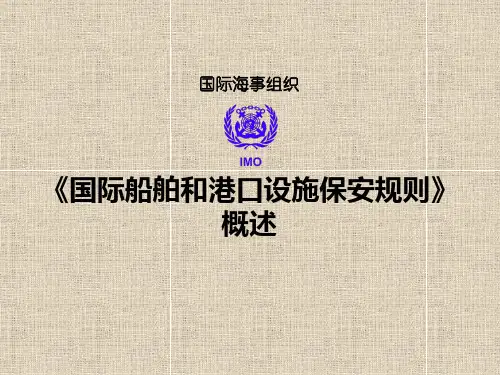
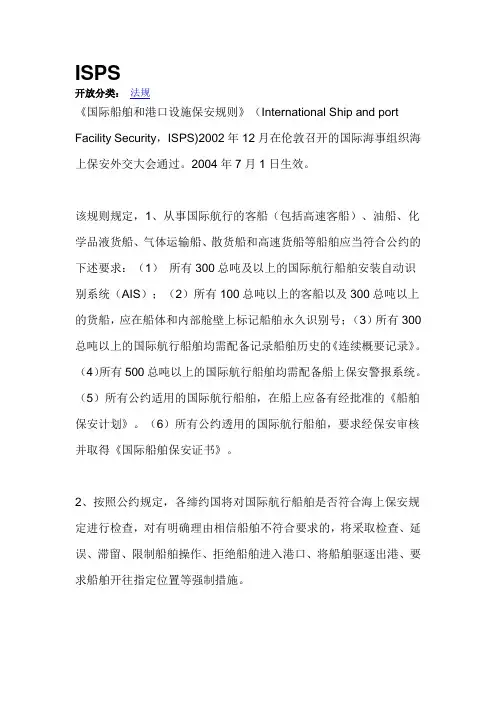
ISPS
开放分类:法规
《国际船舶和港口设施保安规则》(International Ship and port Facility Security,ISPS)2002年12月在伦敦召开的国际海事组织海上保安外交大会通过。
2004年7月1日生效。
该规则规定,1、从事国际航行的客船(包括高速客船)、油船、化学品液货船、气体运输船、散货船和高速货船等船舶应当符合公约的下述要求:(1)所有300总吨及以上的国际航行船舶安装自动识别系统(AIS);(2)所有100总吨以上的客船以及300总吨以上的货船,应在船体和内部舱壁上标记船舶永久识别号;(3)所有300总吨以上的国际航行船舶均需配备记录船舶历史的《连续概要记录》。
(4)所有500总吨以上的国际航行船舶均需配备船上保安警报系统。
(5)所有公约适用的国际航行船舶,在船上应备有经批准的《船舶保安计划》。
(6)所有公约透用的国际航行船舶,要求经保安审核并取得《国际船舶保安证书》。
2、按照公约规定,各缔约国将对国际航行船舶是否符合海上保安规定进行检查,对有明确理由相信船舶不符合要求的,将采取检查、延误、滞留、限制船舶操作、拒绝船舶进入港口、将船舶驱逐出港、要求船舶开往指定位置等强制措施。
3、经营国际航线的船舶所有人或经营人、管理人,应当按照《1974年国际海上人命安全公约》(SOLAS)和ISPS规则的有关规定,编制国际航行船舶的保安计划,指定并培训公司保安员及船舶保安员,为所属国际航行船舶配备规定的设备、文件和标识,申请船舶保安评估。
中国已接受该公约。
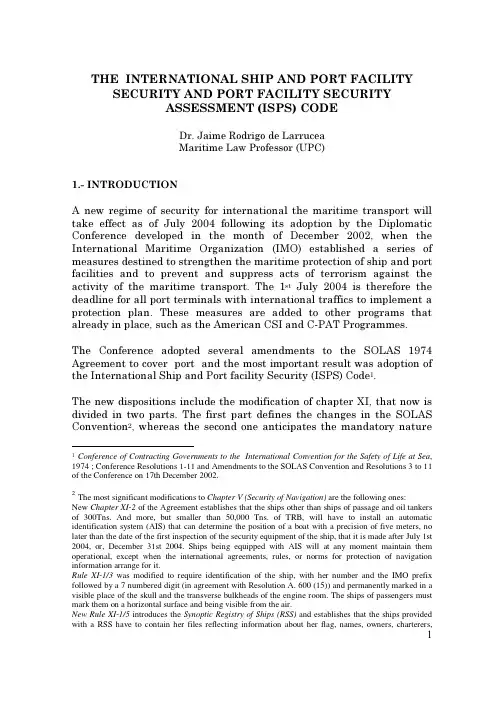
THE INTERNATIONAL SHIP AND PORT FACILITYSECURITY AND PORT FACILITY SECURITYASSESSMENT(ISPS) CODEDr. Jaime Rodrigo de LarruceaMaritime Law Professor (UPC)1.- INTRODUCTIONA new regime of security for international the maritime transport will take effect as of July 2004 following its adoption by the Diplomatic Conference developed in the month of December 2002, when the International Maritime Organization (IMO) established a series of measures destined to strengthen the maritime protection of ship and port facilities and to prevent and suppress acts of terrorism against the activity of the maritime transport. The 1st July 2004 is therefore the deadline for all port terminals with international traffics to implement a protection plan. These measures are added to other programs that already in place, such as the American CSI and C-PAT Programmes. The Conference adopted several amendments to the SOLAS 1974 Agreement to cover port and the most important result was adoption of the International Ship and Port facility Security (ISPS) Code1.The new dispositions include the modification of chapter XI, that now is divided in two parts. The first part defines the changes in the SOLAS Convention2, whereas the second one anticipates the mandatory nature1Conference of Contracting Governments to the International Convention for the Safety of Life at Sea, 1974 ; Conference Resolutions 1-11 and Amendments to the SOLAS Convention and Resolutions 3 to 11 of the Conference on 17th December 2002.2The most significant modifications to Chapter V(Security of Navigation) are the following ones:New Chapter XI-2 of the Agreement establishes that the ships other than ships of passage and oil tankers of 300Tns. And more, but smaller than 50,000 Tns. of TRB, will have to install an automatic identification system (AIS) that can determine the position of a boat with a precision of five meters, no later than the date of the first inspection of the security equipment of the ship, that it is made after July 1st 2004, or, December 31st 2004. Ships being equipped with AIS will at any moment maintain them operational, except when the international agreements, rules, or norms for protection of navigation information arrange for it.Rule XI-1/3was modified to require identification of the ship, with her number and the IMO prefix followed by a 7 numbered digit (in agreement with Resolution A. 600 (15)) and permanently marked in a visible place of the skull and the transverse bulkheads of the engine room. The ships of passengers must mark them on a horizontal surface and being visible from the air.New Rule XI-1/5 introduces the Synoptic Registry of Ships (RSS) and establishes that the ships provided with a RSS have to contain her files reflecting information about her flag, names, owners, charterers,1of adopting the new ISPS Code, approved in that same meeting. From the very beginning of this process it was clear that the reference and main responsibilities for these new safety measures would be for the national Governments. Within the ISPS Code, functions and tasks of "the Contracting Governments" are directly and constantly referred to.An detailed exam of the text and the dispositions of the Code, quoting duties and obligations of the Contracting Governments, emphasises that initiation and maintenance of the processes and procedures necessary to implement the applicable elements of the ISPS Code start and finish with the national Governments members of the International Maritime Organization and signatories of the Code and the corresponding conventions.This Code recognizes terrorism as the greatest threat weighting on maritime transport. Part "A" contains mandatory dispositions, whereas part “B” refers to dispositions with guidance character.2.- THE ROLE OF THE CONCESSIONARIES OF A PORTINSTALLATION.The identification of a number of possible ship/port interfaces will take place in the areas and port facilities set within the located parts belonging to concessionary businesses related to their traffic and activity. Before the regulations of the Code, the concessionary companies had to maintain levels of security similar to those of the port where they were located, so that they themselves did not represent individual threats untied from the global security of the port.With the entry into force by the ISPS Code, direct responsibility for the protection of the installation returns now to each single concessionary business, which will be forced to manage the corresponding Port Facility Security Plan (PFSP).All previous plans have to be approved and admitted by the PFSP, and considered suitable and sufficient to guarantee the protection of those facilities, so that at any moment they are in line with the effectiveness foreseen in the Port Facility Security plan of the Port (PFSP).The maintenance of the operative conditions of any of the plans of a port installation must be preformed on a day-to-day basis by theclassification societies, etc. Any change will be registered in the RBS, in order to provide updated information to the day, along with the history of the preformed changes.2concessionaire, independently whether the assessment plans were designed and developed by them or decided with the corresponding Port Authority.The particular case of the PFSP can go through any of these two alternatives:1.PFSP planned by own concession2.PFSP decided in accordance with the Port Authority.3.- CONSIDERATIONS ABOUT THE EXPRESSION “SHIP/PORT INTERFACE”.A fundamental aspect defining the application frame of the ISPS Code is given by the expression ship/port interface; The Code does not contribute to a definition allowing to clarify its reach and its limitations.Knowing when and where exactly the application of the Code has to start is not of easy, comfortable and homogenous answer. Nevertheless, variations in this consideration can in reality mean a great dispersion in the decision making processes or the implementation of its measures.The Communication COM/2003/0229 final from the Commission to the Council and defines in its article 2 the ship/port interface as follows:"the interaction that takes place when a ship is affected directly and immediately by activities that involve the movement of people or merchandise or provision of port services to the ship or from this one".This definition comes to consider how and when we can talk about a ship/port interface, but it does not facilitate the determination of the moment or physical distance that in operational application of the security is always necessary to establish, and even more when the Code establishes, in point 5 of the introduction of the Annex, that "... the provisions relating to port facilities should relate solely to the ship/port interface”.The logical exposition would be to start from the figure of the ship as a primary target around which the whole Code is structured, and so being able to establish that the dividing line marking the limit is given by what represents the first line of protection control.3It has to be considered that the establishment of the limit from ashore towards the ship could correspond to the public port dominion of the port installation.In the establishment of criteria for determining of the ship/port interface, is the real possibility to find a zone of dockage without interface, where the access is given directly from the gangway of the ship, without an existing preventive or restricted zone to perform controls.Until now it has been considered that terrestrial transport was made using road networks supported by trucks and tractors that in reality can practically arrive at the flank of the ship so to embarked directly, but if modal railway transport is considered, a new distinctive necessity arises, since most of the present situations. The only control of these units consists of the access by a door without controls at the borders of the port public dominion, without at no later moment having any additional controls and being it therefore necessary in accordance with the principles applied until now- that the physical point where they are due to out, have to be decided and thus defining the ship/port interface.A new uncertainty in the ship/port interface appears when the ship is in waters port public dominion, being it necessary to consider the different possible situations:•Moored.•Moored and operating.•In manoeuvres.•In navigation.In principle, the maritime surface is of exclusive dependency of the corresponding Port Authority, nevertheless, different aspects can be determined:•When does the bond of responsibilities begin?•Under which conditions during the operations of the ship before dockage?In analysing each block of possibilities while the ship is in port waters of public dominion, the following conclusions can be obtained:A. Voluntary anchorage of the ship in port waters without her intention to accomplish operations, by any cause of navigation when the ship looks for refuge due to bad weather outside the sheltered zone, for4emergency repair, etc., in which case, either the Port Authority or Maritime Authority authorize the situation and assign an area of anchorage without benefiting from the service of pilotage, the ship depends on their Ship Security Assessment (SSA).B. Forced anchorage of the ship in port waters in order to conduct operations, while awaiting dockage, tide, loading, bunkering while moored, taking of provisions and/or trough, etc., with benefit of the service of pilotage, being representatives of the Port Authority, the ship establishes an interface with the port.C. Any operation conducted with other ships and boats while in anchorage, establishes a ship-to-ship interface and subsequently an interface between their respective SSAs.D. Any situation in which the ship is in navigation and manoeuvres until reaching dockage and mooring, the port creates an interface with the ship through the indirect services that are being rendered.Considering all these diverse alternatives, it is evident that each port installation and each partial or total zone related to the ship, must have previously determined a distance of applicable interface, and when it is not possible because of the port features, to consider the public dominion of the same one as the influence interface, although this treatment represents a strong complication by the scope it includes.Despite the aforementioned, the successive controls starting from the first and not yet being the objectives of Code ISPS of application, they will have to be closely coordinated amongst each other in order to create the necessary sealing of the protection system.4. - JURIDICAL ASPECTS OF THE PORT PROTECTION4.1. INTRODUCITONEurope insists in finding protection solutions with a worldwide impact as the EU operated in a global economic context. But at the same time, Europeans point out that maritime protection should not turn into a unfair competence issue in particular within the EC boundaries. It is worth noting that the measures adopted by the diplomatic Conference it is limited to ships and port infrastructures, integrated by the ship/port5interface, but not to the harbours themselves, for which the Commission is already working on a legislative initiative to regulate their protection. The main object of this regulation3 is to settle and apply communitarian measures to improve vessel protection used both in international and national traffic, together with the port infrastructures related to them in front of illicit deliberate actions. Additionally, the Regulation pretends to establish a platform for the harmonised interpretation and application, and the communitarian control, of special measures to increase the maritime protection approved by the Diplomatic Conference of the IMO. In this sense, the Spanish regulation goes further than the IMO measures, as it makes compulsory some ISPS Code sections which are only contemplated as recommendations in their original text (for example it broadens the measures to the passenger ships in national trips and it also increases the security analysis for certain national voyages).4.2. - NATIONAL PORT SECURITY AUTHORITIES.The ISPS Code states that the Contracting Governments and or their respective authorities shall adopt a series of measures to comply with its requisites and sections.Given the fact that certain countries have many port installations and huge geographical extensions in need of security analysis, certain sections assign several tasks and responsibilities at the local level of that country. It will be the responsibility of the designated Authority to determine what measures are necessary at national level to comply with the ISPS Code and to establish a cooperation field between the several governmental organisations, local administrations and port and maritime transport sector.It also establishes that such an Authority shall limit the functions and duties of those entities to guarantee the maritime security at national and international level.4Despite the establishment of a cooperation field between governmental organisms with specified duties, the maritime commerce dynamics and3Proposal for a Regulation of the European Parliament and of the Council on Enhancing Ship and Port Facility Security (presented by the Commission) COM (2003) 229 final 2003/0089 (COD).4 Ibíd. Part A, Section 1.2.6the port installations will most probably require the assistance of non-governmental organisations and that of the private sector. The ISPS Code also states that the Designated Authority can allow that Recognised Security Organisations (RSO) undertake certain functions related to the security of port installations and services.4.3. - RECOGNISED SECURITY ORGANISATIONS.In its article 4.3 of its Part A, the ISPS Code states the Designated Authority can allow certain Recognised Security Organisations (RSO)5 undertake certain functions related to the security of port installations and services. It is necessary to consider the type of functions that could be performed by these organisations recognised to evaluate their competence to perform the assigned tasks. A Port Authority could be designated or even a port service or installation provider as Recognised Security Organisations, provided it has the certificate contemplated in the ISPS Code. 6A Recognised Security Organisations is defined as ‘… the organisation that has been recognised by the Spanish Maritime Administration or any other Member State of the European Union7…’, being a classification society8 or another private entity which evaluates the maritime security in the name of a Member State of the European Union and that has been recognised to take such activities under the Regulation. As soon as the5 See also: Resolution IMO A. 739 (18), Annex, Appendix 1)-(“ Directions relative to the authorisation of the organisations that act in the name of the Administration”), Resolution OMI A. 789 (19)-(“Specifications related to the functions of recognising and certification of the recognised organisations acting in the name of the Administration) and Circular MSC.6 Ibíd. Part B, Sections 4.3 and ff.7 Ibíd. Art. 2.g).8 The EU has recognised the following Classification Societies:•American Bureau of Shipping (ABS)•Bureau Veritas (BV)•China Classification Society (CSS)•Det Norske Veritas (DNV)•Germanischer Lloyd (GL)•Hellenic Register of Shipping (HRS)•Korean Register of Shipping (KR)•Lloyd’s Register of Shipping (LR)•Nippon Kaiji Kyokai (NK)•Registro Italiano Navale (Rina)•Registro Internacional Naval (Rinave)•Russian Maritime Registry of Shipping (RS)7Public Infrastructures Ministry had authorised an RSO to undertake those inspections and controls stated in the Regulation through authorisations, this will convert into an authorised Organisation.According to the Code, a port, a Port Authority or those trading with port installations could be designated as an RSO as long as they posses the relevant know how in protection issues9, including the approbation of vessel security plans, or modification of them, in the name of the Administration; verification and certification that the vessel complies with provisions contained in chapter XI-2 and in part A of the ISPS Code, to take evaluations of the protection of the port installations required by the contracting government and the assistance of the companies or port installations regarding the protection of the port infrastructures. In case an RSO had already evaluated the vessel, that same RSO will not be able to be authorised to approve the vessel protection plan.4.4. - THE PORT AND THE PORT AUTHORITY AS RSOs.The ISPS Code states in Part B (art. 4.7) that it is possible to designate as RSO a port, a Port Authority or the owner of a port installation if they are in possession of the necessary know-how of the protection issues, including:1.Specialised knowledge of the relevant protection issues2.Relevant knowledge of the operation of the vessels and theharbours, including detailed knowledge of the project and portconstruction3.Capacity to evaluate the common risks in relation to protectionof the port operations and the port installations including theship-port interface and way to reduce such risks.4.Capacity to update and improve the specialised knowledge of itspersonnel5.Capacity to control that its personnel are confident6.Capacity to maintain the appropriate measures to avoid its nonauthorised divulgation7.Knowledge of chapter XI-2 and part A of the Code and thenational and international legislation relevant to the subject ofprotection and security8.Knowledge of the tendencies and threats to protection9.Knowledge of detection of weapons and dangerous goods10.K nowledge of recognition of dangerous people11.K nowledge of the techniques used to avoid protection measures 9 Consideration of the ISPS Code, Annex 1, Part B, Sections 4.7 and ff.812.K nowledge of equipments and systems of protection andwatching and of its operational limitation.4.5. - OPERATIVE FIGURESIn the concept of the several types of interface created according to the operational characteristics of the port installations, certain aspects can be identified that need to be précised:A) Port Facility Security Officer (PFSO)Paragraphs n 17 refer to the profiles committed to the Port Facility Security Officer (PFSO) that will be designated to each and every port installation. His responsibilities will focus on evaluate a complete initial evaluation of the port installation, guarantying and implementing the elaboration and maintenance of the protection plan of the port installation and taking periodical inspections of protection of the installation to make sure that the measures of protection are still covering gaps and upgrading the plan according to the changes in the installation.B)SHIP SECURITY OFFICER (SSO) AND COMPANY SECURITY OFFICER (CSO)The figures of the SSO and CSO do not precise additional interpretations, for its presence is a policy of relation with the human resources established either by the carrier or by the port in question.The Flag State Implementation (FSI) subcommittee of the IMO has decided to recommend to the Maritime Safety Committee (MSC) to establish that the Master of a vessel could be designated as Ship Security Officer10. However, with the CSO figure doubts can be raised to consider the interface located in the vessel.1.When the vessel has its own port terminal, the company is presentat all times and its disposal is immediate, covering the necessary protection needs in a large number of probabilities in the interface.2.when the vessel is in a service terminal of another owner, if thecompany has representation at the harbour, it is also easy to designate a person of their staff to assume CSO functions.10 See Briefing 11/2004 of the Subcommittee (FSI).93.the problem arises frequently, when the vessel arrives at port inwhich the ship owner has no branch, two solutions can be adopted:a.the consignee will be the CSOb.the port installation will designate a person.According to 3.a. the consignee will represent another dimension of the ship owner, compatible with the existing one, that make possible the final objective of commercial maritime transport.According to 3b many negative aspect will arise, for the person will not be hundred per cent independent and the port installation can see its duties and protection affected.4.6. - PORT FACILITY SECURITY ASSESSMENT (PFSA).The PFSA establishes the relative importance of the different structures and facilities for the functioning of a port installation. This process of identification and evaluation is crucial, since it is the base for determining strategies of risks attenuation related to goods and structures and to protect them against an upcoming negative event. This process will take into consideration possible loss of lives, economic importance of the port, its symbolic value and the presence of governmental facilities.The correct assessment of protection, carried out by professionals with deep knowledge in harbour security, is a process that has to identify goods and infrastructures that are important to protect; to select and to classify by precedence measures to resist threats to the detected soft spots. The PFSA must consider aspects of the harbour installation, its physical protection and structural integrity, the systems of personnel protection, norms and procedures, radio electric and telecommunications systems, including computer science systems and networks; transport infrastructure; services public; and other zones that, when suffering damages, or used as observation point for illicit aims, could put in danger people, goods or operations that are performed within the harbour installation.4.7. - ARTICLE 132 OF THE SPANISH PORT LAW.10In its article 132, the Spanish Port Law (Law 48/2003 of November 26th: Ley de régimen económico y de prestación de servicios de los puertos de interés general”) establishes an ample and exhaustive control by the Port Authority related to the following areas, not withstanding the competences that correspond to other branches of the Public Administrations and the responsibilities of other users and concessionaires of the port:•Compliance of rules relating to admission, manipulation and storage of dangerous goods.•Compliance of regulations referring to coordination of activities for labour risk prevention11.•Regulations regarding security systems, including protection against antisocial and terrorist acts.In agreement with current legislation on prevention and emergency control, each Port Authority will issue a so-called “Plan of Interior Emergency” for each port they manage and it will be part of the port decrees. “Plan of Interior Emergency” consists of equipping to the Port with their own resources and personnel, able to carry out actions of risks prevention, as well as of alarm, evacuation and aid, fire extinguishing, rescue, salvage and rehabilitation of essential services. With such aim, the aforementioned plan establishes training activities, not only for all the personnel being directly involved, but also for people of the port surroundings.4.8. - FORMAL BINDING AND COHERENCE OF THE PROTECTIONIN THE SPANISH PORT SYSTEM.On the basis of article 16.4 of ISPS Code, the Port Facility Security Plan will have to be combined with the Port Facility Security Plan or any other plan of the Port for emergency situations, or be part of them. Unlike loading ports, cruises ports and terminals must take measures that correspond to the civil defence, given the number of passengers they transport and interact with ship/port interface, the commercial and administrative areas that are part of the terminals and the areas visited within the tourist site.5. - CONCLUSIONS11 Refer to rules established in article 24 of the Spanish Law 31/1995, of November 8th.11The Code the International of Protection of Ships and Port Facilities represents a complete programme to improve the general profile of security in the international maritime commerce. It give Contracting Governments a direction endorsed by a methodology that is centred in the identification of assets and the vital infrastructure for an uninterrupted and safe flow of commercial maritime operations, recognizing, at the same time, that there can be vulnerabilities that put those critical elements at risk.Having identified those vulnerabilities, the ISPS Code offers a direction for elaborating, approving and implementing suitable security plans that will eliminate or attenuate the exhibition of those vulnerabilities to well-known or perceived threats.The ISPS Code does not have to be considered a unique and absolute source with regard to international port security, but has to be seen like a document containing a series of norms and optimal practices that offer Contracting Governments or Designated Authorities a matrix for formulating their programmes and national plans of port security, granting them space to carry out amendments and modifications, as conditions or threats vary with time. The ISPS Code has to be considered a dynamic document that will adapt to the changing nature of ports, their operations and infrastructure, and to the nature of threats they are exposed to.12。
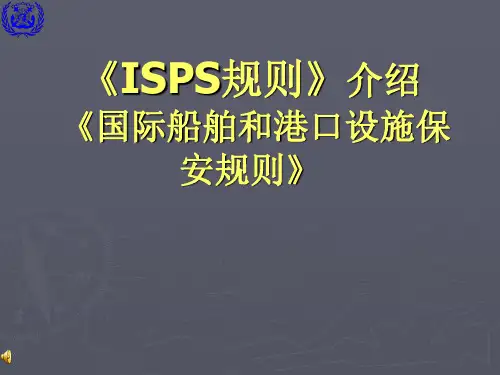
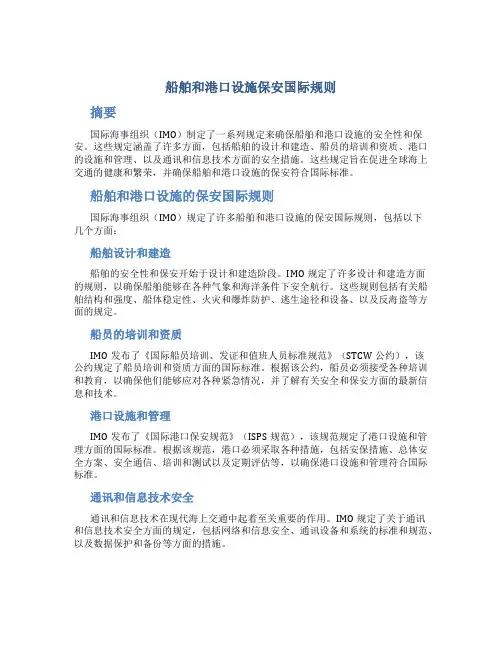
船舶和港口设施保安国际规则摘要国际海事组织(IMO)制定了一系列规定来确保船舶和港口设施的安全性和保安。
这些规定涵盖了许多方面,包括船舶的设计和建造、船员的培训和资质、港口的设施和管理、以及通讯和信息技术方面的安全措施。
这些规定旨在促进全球海上交通的健康和繁荣,并确保船舶和港口设施的保安符合国际标准。
船舶和港口设施的保安国际规则国际海事组织(IMO)规定了许多船舶和港口设施的保安国际规则,包括以下几个方面:船舶设计和建造船舶的安全性和保安开始于设计和建造阶段。
IMO规定了许多设计和建造方面的规则,以确保船舶能够在各种气象和海洋条件下安全航行。
这些规则包括有关船舶结构和强度、船体稳定性、火灾和爆炸防护、逃生途径和设备、以及反海盗等方面的规定。
船员的培训和资质IMO发布了《国际船员培训、发证和值班人员标准规范》(STCW公约),该公约规定了船员培训和资质方面的国际标准。
根据该公约,船员必须接受各种培训和教育,以确保他们能够应对各种紧急情况,并了解有关安全和保安方面的最新信息和技术。
港口设施和管理IMO发布了《国际港口保安规范》(ISPS规范),该规范规定了港口设施和管理方面的国际标准。
根据该规范,港口必须采取各种措施,包括安保措施、总体安全方案、安全通信、培训和测试以及定期评估等,以确保港口设施和管理符合国际标准。
通讯和信息技术安全通讯和信息技术在现代海上交通中起着至关重要的作用。
IMO规定了关于通讯和信息技术安全方面的规定,包括网络和信息安全、通讯设备和系统的标准和规范、以及数据保护和备份等方面的措施。
船舶和港口设施的保安国际规则是确保全球海上交通健康和繁荣的关键因素。
这些规则涵盖了许多方面,包括船舶的设计和建造、船员的培训和资质、港口的设施和管理、以及通讯和信息技术方面的安全措施。
通过遵守这些规定,我们可以确保船舶和港口设施的保安符合国际标准,从而提高全球航运业的安全和保障。
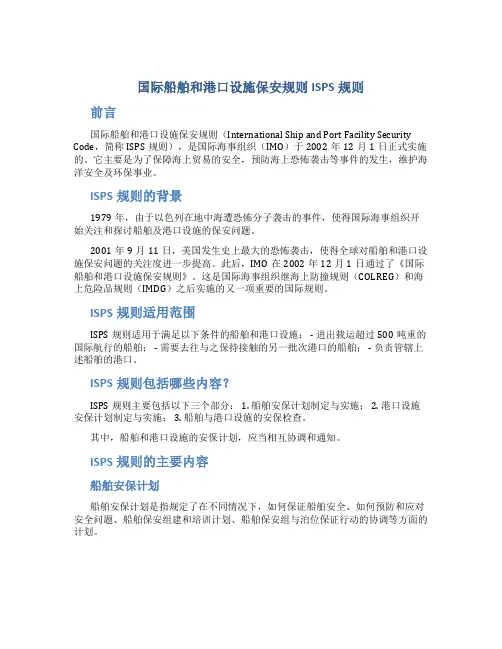
国际船舶和港口设施保安规则ISPS规则前言国际船舶和港口设施保安规则(International Ship and Port Facility Security Code,简称ISPS规则),是国际海事组织(IMO)于2002年12月1日正式实施的。
它主要是为了保障海上贸易的安全,预防海上恐怖袭击等事件的发生,维护海洋安全及环保事业。
ISPS规则的背景1979年,由于以色列在地中海遭恐怖分子袭击的事件,使得国际海事组织开始关注和探讨船舶及港口设施的保安问题。
2001年9月11日,美国发生史上最大的恐怖袭击,使得全球对船舶和港口设施保安问题的关注度进一步提高。
此后,IMO在2002年12月1日通过了《国际船舶和港口设施保安规则》。
这是国际海事组织继海上防撞规则(COLREG)和海上危险品规则(IMDG)之后实施的又一项重要的国际规则。
ISPS规则适用范围ISPS规则适用于满足以下条件的船舶和港口设施: - 进出载运超过500吨重的国际航行的船舶; - 需要去往与之保持接触的另一批次港口的船舶; - 负责管辖上述船舶的港口。
ISPS规则包括哪些内容?ISPS规则主要包括以下三个部分: 1. 船舶安保计划制定与实施; 2. 港口设施安保计划制定与实施; 3. 船舶与港口设施的安保检查。
其中,船舶和港口设施的安保计划,应当相互协调和通知。
ISPS规则的主要内容船舶安保计划船舶安保计划是指规定了在不同情况下,如何保证船舶安全、如何预防和应对安全问题、船舶保安组建和培训计划、船舶保安组与泊位保证行动的协调等方面的计划。
港口设施安保计划港口设施安保计划是指综合考虑港口的各个方面问题,制定安保计划,以尽可能防止和预测可能发生的恐怖事件并迅速应对。
安保检查安保检查是指船舶和港口设施在确保安全的前提下,进行一系列的安全检查,以防止可能的恐怖袭击。
ISPS规则的作用ISPS规则的实行,对于保障海上安全、维护海洋环境和贸易也发挥了很大的作用。
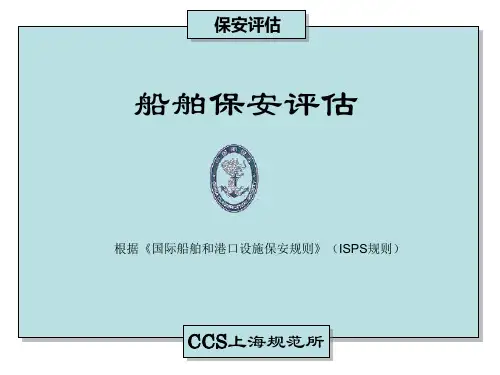
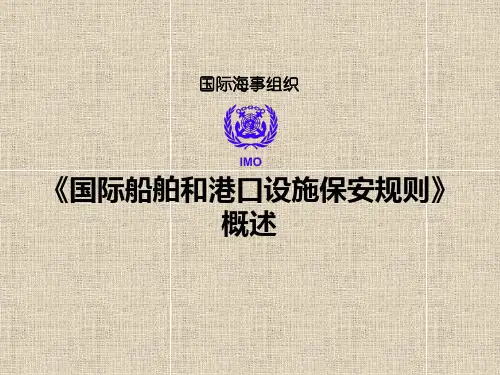
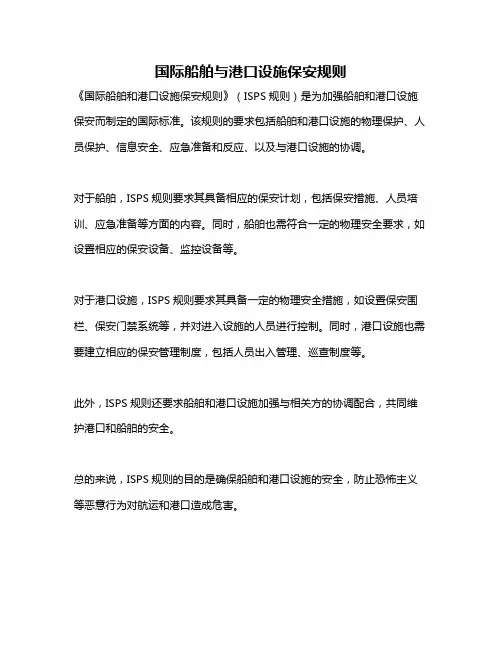
国际船舶与港口设施保安规则
《国际船舶和港口设施保安规则》(ISPS规则)是为加强船舶和港口设施保安而制定的国际标准。
该规则的要求包括船舶和港口设施的物理保护、人员保护、信息安全、应急准备和反应、以及与港口设施的协调。
对于船舶,ISPS规则要求其具备相应的保安计划,包括保安措施、人员培训、应急准备等方面的内容。
同时,船舶也需符合一定的物理安全要求,如设置相应的保安设备、监控设备等。
对于港口设施,ISPS规则要求其具备一定的物理安全措施,如设置保安围栏、保安门禁系统等,并对进入设施的人员进行控制。
同时,港口设施也需要建立相应的保安管理制度,包括人员出入管理、巡查制度等。
此外,ISPS规则还要求船舶和港口设施加强与相关方的协调配合,共同维护港口和船舶的安全。
总的来说,ISPS规则的目的是确保船舶和港口设施的安全,防止恐怖主义等恶意行为对航运和港口造成危害。

中华人民共和国国际船舶保安规则(2019年修订)文章属性•【制定机关】交通运输部•【公布日期】2019.06.03•【文号】中华人民共和国交通运输部令2019年第15号•【施行日期】2019.06.03•【效力等级】部门规章•【时效性】现行有效•【主题分类】水运正文中华人民共和国国际船舶保安规则(2007年3月26日交通部发布根据2019年6月3日《交通运输部关于修改〈中华人民共和国国际船舶保安规则〉的决定》修订)第一章总则第一条为加强国际航行船舶保安管理,根据经过修订的《1974年国际海上人命安全公约》(以下简称SOLAS公约)和《国际船舶和港口设施保安规则》(以下简称ISPS规则)的规定,制定本规则。
第二条本规则适用于下列从事国际航行的中国籍船舶和从事国际航运业务的中国公司以及进入中国管辖海域的外国籍船舶:(一)客船;(二)500总吨及以上的货船;(三)500总吨及以上的特种用途船;(四)移动式海上钻井装置。
适用本规则的船舶以下简称船舶。
本规则不适用于军用船舶和仅用于政府公务用途的船舶。
第三条交通运输部主管全国船舶保安工作。
中华人民共和国海事局负责具体执行SOLAS公约和ISPS规则规定的缔约国政府船舶保安主管机关的职责。
交通运输部在沿海设立的海事管理机构按照本规则具体履行下列职责:(一)负责管理船舶保安员和公司保安员的培训,对通过规定的船舶保安培训并经考试合格者,签发相应的培训合格证;(二)接收船舶海上保安信息,并在法定的职责内按照规定的程序采取相应的行动;(三)向已经进入中国领海或者已经报告拟进入中国领海的船舶提供相应的保安信息,向相关部门通报保安信息,并按照法定职责采取相应的行动;(四)实施船舶保安监督管理,检查《船舶连续概要记录》、《国际船舶保安证书》、《临时国际船舶保安证书》、保安报警装置、保安演习以及本规则规定的其他船舶保安事项,检查已经审核合格的船舶保安计划以及修订内容的有效性;(五)对船舶保安员、公司保安员实施监督管理;(六)中华人民共和国海事局规定的其他船舶保安职责。
国际船舶和港口设施保安规则国际船舶和港口设施的保安规则是为了确保船舶和港口的安全性,防止恐怖袭击、非法贩运和非法入侵等安全威胁。
1.国际船舶保安规则(ISPS规则):该规则要求船舶所有者和港口设施经营者采取一系列措施,包括制定安全计划、进行安全评估、配备安全设备等,以确保船舶和港口的安全。
2.船舶登记和身份识别:船舶所有者必须向相关当局注册船舶并获取唯一标识码(IMO编号),以确保身份识别和追踪。
3.安全检查和监控:港口设施需要对进入港口的船舶和人员进行安全检查,并配备相应的监控系统和设备,以及安全人员进行巡逻和监视。
4.安全设备和技术:船舶和港口设施需要配备适当的安全设备,如闭路电视监控、防火和泄漏控制系统、报警系统等。
5.保安人员培训和认证:船舶和港口设施的保安人员需要接受相关培训,并获得认证,以提高应对突发事件和安全威胁的能力。
6.信息共享和合作:船舶和港口设施需要建立信息共享机制,与相关当局、国际组织和其他港口进行合作,分享和获取安全信息,以提前预防和应对安全威胁。
总之,国际船舶和港口设施的保安规则旨在确保船舶和港口的安全,促进国际贸易的顺利进行。
这些规则需要船舶所有者和港口设施经营者履行相关义务,确保其运营符合国际安全标准。
7. 港口入口控制:港口应设立有效的入口控制系统,确保只有经过安全检查的人员和车辆才能进入港口区域,并对进出港口的货物进行有效的安全检查。
8. 港口安全计划:港口设施经营者应制定详细的安全计划,包括应对恐怖袭击、危险品泄漏、火灾和其他突发事件等的应急措施,并定期进行演练和评估。
9. 船舶安全巡航和护航:海上巡逻和护航队伍应在国际水域和敏感区域进行巡航,确保船舶的安全,并防范海盗和恐怖袭击等威胁。
10.货物安全:港口应采取措施确保货物的安全,包括货物的安全封条、有效的货物追踪系统、货物安全检查等。
11.船舶和港口紧急通信系统:船舶和港口设施应建立紧急通信系统,以便在紧急情况下及时获取帮助和进行协调。
国际船舶和港口设施保安规则(ISPS规则)国际船舶和港口设施保安规则序言1. 为了加强海上保安,2002年12月在伦敦召开的海上保安外交大会通过了《1974年海上人命安全公约》的新规定和本规则*。
这些新要求构成了船舶和港口设施可以合作探察并制止威胁海运业保安行为的国际框架。
2. 在2001年9月11日的灾难事件之后,国际海事组织(本组织)于2001年11月召开的第22届大会一致同意,制订关于船舶和港口设施保安的新措施,由2002年12月召开的《1974年海上人命安全公约》缔约国政府大会(又称海上保安外交大会)通过。
本组织的海上安全委员会(海安会)受到委托,在成员国、政府间国际组织和在本组织享有咨询地位的非政府组织提案的基础上进行外交大会的准备工作。
3. 在2001年11月还召开了海安会第一次特别会议。
为了加速适当保安措施的制订和通过,特别会议成立了一个海安会海上保安会间工作组。
海安会海上保安会间工作组第一次会议于2002年2月召开,其讨论结果报告给了海安会第75届会议审议。
会上成立的一个特设工作组又进一步起草了建议草案。
海安会第75届会议审议了特设工作组的报告,建议应于2002年9月再召集一次海安会会间工作组会议。
2002年12月在紧靠外交大会之前召开的海安会第76届会议审议了于2002年9月召开的海安会会间工作组会议的结果和与海安会同期召开的海安会工作组的进一步工作,同意了将被提交给外交大会审议的建议文本的最后一稿。
4. 外交大会(2002年12月9至13日)还通过了对《1974年海上人命安全公约》(74年安全公约)现有条款的修正案,加速自动识别系统安装要求的实施,并通过了74年安全公约第XI-1章的新条款,涉及船舶识别号的标记和《连续概要纪录》的携带。
外交大会还通过了若干大会决议,包括关于本规则的实施和修订、技术合作以及与国际劳工组织和世界海关组织合作的决议。
会议认识到,在这两个组织的工作完成之后,可能需要对某些有关海上保安的新规定进行重新审议和修正。
国际船舶和港口设施保安规则I S P S规则Modified by JEEP on December 26th, 2020.国际船舶和港口设施保安规则序言1. 为了加强海上保安,2002年12月在伦敦召开的海上保安外交大会通过了《1974年海上人命安全公约》的新规定和本规则*。
这些新要求构成了船舶和港口设施可以合作探察并制止威胁海运业保安行为的国际框架。
2. 在2001年9月11日的灾难事件之后,国际海事组织(本组织)于2001年11月召开的第22届大会一致同意,制订关于船舶和港口设施保安的新措施,由2002年12月召开的《1974年海上人命安全公约》缔约国政府大会(又称海上保安外交大会)通过。
本组织的海上安全委员会(海安会)受到委托,在成员国、政府间国际组织和在本组织享有咨询地位的非政府组织提案的基础上进行外交大会的准备工作。
3. 在2001年11月还召开了海安会第一次特别会议。
为了加速适当保安措施的制订和通过,特别会议成立了一个海安会海上保安会间工作组。
海安会海上保安会间工作组第一次会议于2002年2月召开,其讨论结果报告给了海安会第75届会议审议。
会上成立的一个特设工作组又进一步起草了建议草案。
海安会第75届会议审议了特设工作组的报告,建议应于2002年9月再召集一次海安会会间工作组会议。
2002年12月在紧靠外交大会之前召开的海安会第76届会议审议了于2002年9月召开的海安会会间工作组会议的结果和与海安会同期召开的海安会工作组的进一步工作,同意了将被提交给外交大会审议的建议文本的最后一稿。
4. 外交大会(2002年12月9至13日)还通过了对《1974年海上人命安全公约》(74年安全公约)现有条款的修正案,加速自动识别系统安装要求的实施,并通过了74年安全公约第XI-1章的新条款,涉及船舶识别号的标记和《连续概要纪录》的携带。
外交大会还通过了若干大会决议,包括关于本规则的实施和修订、技术合作以及与国际劳工组织和世界海关组织合作的决议。
ISPS CODE: international code for the security of ship and of Port facility国际船舶和港口设施保安规则SSP: ship security plan 船舶保安计划SSA: ship security assessment 船舶保安评估SSS: ship security system 船舶保安体系SSO: ship security officer 船舶保安员PFSP: port facility security plan 港口设施保安计划PFSO: port facility security officer 港口设施保安员CSI: container safety initiate 货柜安全倡议CSO: company security officer 公司保安员CSP: company security plan 公司保安计划CSR:Continuous synopsis record 连续概要记录ISSC: international ship security certificate国际船舶保安证书RSO: recognized security organization经认可的保安组织IISSC: initiate international ship security certificate 临时国际船舶保安证书AIS: automatic identification system 自动识别系统DoS: declaration of security 保安声明IAPP:International Air Pollution Prevention Certificate LSA: life saving applianceFFA: fire fighting applianceDPA: designated person ashore。
国际船舶保安规则实施指南
国际船舶保安规则实施指南是根据国际海事组织(IMO)颁布的《国际船舶和港口设施保安法规》(ISPS Code)制定的。
该指南旨在帮助船舶公司和港口管理机构了解、制定和执行船舶和港口设施的保安措施。
该指南涵盖了以下内容:
1. 保安责任:指南明确了船舶和港口设施保安的责任分工,包括船舶公司、船员、港口管理机构和安保公司等。
2. 保安评估:指南提供了保安评估的方法和程序,以评估船舶和港口设施的脆弱性和风险,从而确定相应的保安措施。
3. 保安计划:指南制定了编制保安计划的要求和步骤,包括对保安风险进行分析、确定保安措施和制定应急预案等。
4. 保安装备和设施:指南建议船舶和港口设施根据保安风险的不同,采取适当的保安装备和设施,包括视频监控系统、入侵探测系统和安全通信设备等。
5. 保安培训和演习:指南提供了保安培训计划和演习的指导,以提高船员和港口工作人员对保安工作的认识和应对能力。
6. 保安审核和改进:指南指导船舶公司和港口管理机构进行保安审核,以评估和改进保安措施的有效性和适用性。
通过遵循国际船舶保安规则实施指南,船舶公司和港口管理机构可以提高船舶和港口设施的保安水平,减少安全风险,保障海上运输的安全和畅通。